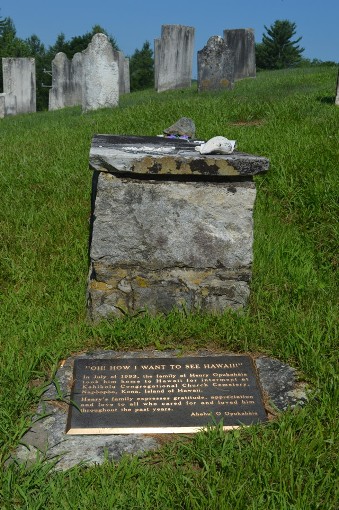by Peter Vermilyea
Heneri Opukaha’ia (Anglicized as Henry Obookiah in his lifetime) was born on the island of Hawaii in 1792. His parents were killed in a civil war and, as a 15- or 16-year-old, Henry was taken aboard the merchant ship Triumph, commanded by Captain Britnall and bound for New Haven. While on board the ship, Henry befriended Thomas Hopu, a Hawaiian cabin boy who taught his fellow islander English.
While in New Haven, Opukaha’ia studied under Reverend Edwin Dwight, a recent graduate of Yale. In addition to the traditional curriculum for tutors and pupils of the time, Opukaha’ia focused especially on English grammar. During the course of his education, Opukaha’ia was exposed to Christianity and he not only converted but asked for training so that he could spread the gospel on his home islands. This resulted, in part, in the founding of the Foreign Mission School in Cornwall. Over its 10 years of operation, the school educated 100 students, including 43 Native Americans and 20 Hawaiians.
While a student in Cornwall, Opukaha’ia worked on farms in Torrington and Litchfield to support himself. The Litchfield community encouraged Henry to systemize the Hawaiian language through the writing of a dictionary and books on common grammar and spelling. Opukaha’ia also began his memoirs.
Unfortunately, before these projects could be completed, Henry fell ill. Diagnosed with typhus fever by Dr. Calhoun of Cornwall, Henry died in February 1818. His last words were reportedly “Alloah [sic] o ‘e,” which Rev. Dwight, who took up the task of preparing the memoirs for publication, translated as “My love be with you.”
The Reverend Lyman Beecher of Litchfield presided over Opukaha’ia’s funeral, stating:
He came to this land and hearing of Him on whom without hearing,
he could not believe, and by the mouth of those who could never
have spoken to him in Owyhee.
Opukaha’ia was buried in the Cornwall Cemetery, but in 1993 family members in Hawaii had his body reinterred at the Kahikolu Congregational Church Cemetery, Napòopòo, Hawaii. The Cornwall gravesite is marked with a plaque thanking the community for caring for Henry and is topped with his words, “Oh! How I want to see Hawaii!”
Peter Vermilyea, who teaches history at Housatonic Valley Regional High School in Falls Village, Connecticut, and at Western Connecticut State University, maintains the Hidden in Plain Sight blog and is the author of Hidden History of Litchfield County (History Press, 2014).
Note: ConnecticutHistory.org does not edit content originally published on another platform and therefore does not update any instances of outdated content or language.










